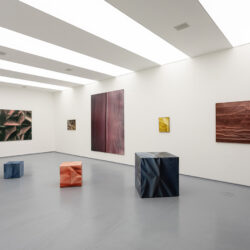Pauer’s artistic program was based on his Pseudo manifesto dating from 1970, which brought together conceptualism and the sensuality of sculpture to a common platform. His paintings reach back to the solid base of Pseudo within a new medium. The artist’s spray-gun paintings, like his earlier works which were conceptualized in the frame of sculpture, put the emphasis on the interplay of light and shadow, as well as on the contradiction of plasticity and two-dimensionality. Pauer intended his images to be objective constructions, although his lyrical color selection may still generate a sort of subjective, associative emotions in the viewers.
As the artist himself writes in 2007: “These are not abstract paintings, they don’t have any abstract meaning, they are not descriptive, they are not epic, they are not narrative, they don’t even have a story, their stories are already over. They depict moments, with the elementary power of light and shadow and colors (.) I would call them radical paintings because they don’t have any other goal than to become paintings. They reach out to the roots of painting and they force the viewer to interpret them and to interact with them. They don’t represent anything else besides their paintingness. The colors which substitute light and the shadow, that represent the lack of light, bear the monochromic nature of the pseudo-technique and aerography.”
Beyond the works created in the 2000s, acb Gallery also aims to provide a small-scale retrospect through a few works that demonstrate Pauer’s first attempts towards pseudo painting. Such as a pseudo piece from the 1970s, as well as the triptych from 1980 called Autumn Variations, that Annamária Szőke, Pauer’s monographist, traces back to the pseudo painting program.
Gyula Pauer started his artistic career as a member of the Surenon group at the end of the 1960s. His early large-scale works, such as the Pseudo Relief of Villány, or The Famous Pseudo Tree of Nagyatád, as well as the Protest Sign Forest, consisting of 131 wooden protest signs, survived only in the form of documentation and reconstruction. His most well-known work created together with Can Togay is the Holocaust Memorial of Budapest, the Shoes on the Danube Bank. His broad activities in theater- and filmmaking were interconnected with his life-long Pseudo program. His collaborations in scenography and visual design on motion pictues, such as with Béla Tarr on Damnation or Sátántangó, or with Géza Bereményi, are iconic. The Kossuth prize-awarded artist’s works can be found at prestigious collections such as MUMOK, Vienna, the Hungarian National Gallery, the St. Stephen’s King Museum in Székesfehérvár, and the Janus Pannonius Musem in Pécs.

